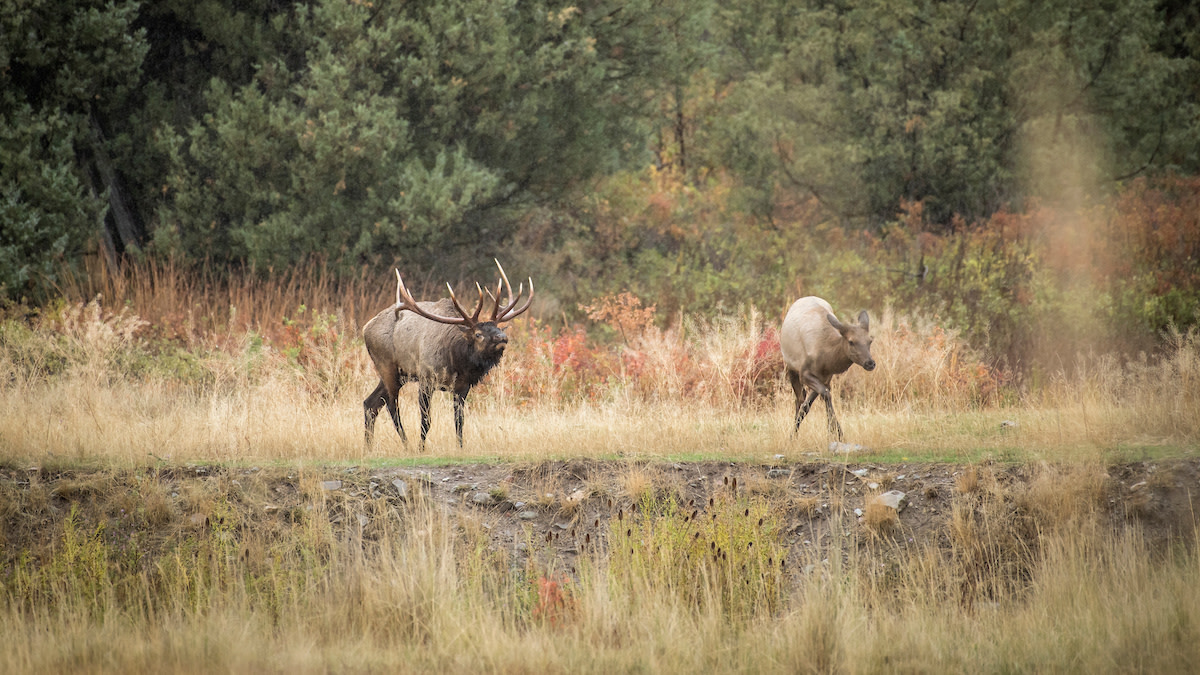
“I was pinned down. I couldn’t move or he’d see or hear me,” I explained. “We were only 12 yards apart with a tree in between.”
Greg looked at me blankly.
“Why didn’t you just run in there and kill him?”
This was a long time ago, but it was a revelation in my elk hunting knowledge. Greg has been killing bulls with a stick bow far longer than I’ve been alive and he clearly thought I was dumb for being afraid to move or make noise while up close and personal with a bull elk in the timber.
I’ve come to notice that many hunters who are trying to take the next step from deer to elk commit similar mistakes. It’s completely forgivable when whitetails, blacktails, or mule deer are your only basis for understanding. We’re trained in caution, patience, and silence from an early age in the deer woods. But elk are on average three times bigger than your typical deer, and their ecology and behavior are a world apart. It would be like saying “I know how to catch trout—now I’m going to apply that to king salmon.” Same family, entirely different beast.
Mule deer are a lot more like elk in their habitat at least, and certainly in the ways you hunt them, but they sure as hell can see and hear a lot better. Elk are their own animal and appreciating that distinction can help you succeed in one of the world’s hardest hunts. Here’s what you can, can’t, and should do.
You Can Make Noise In fact, I recommend it. So does Jason Phelps. Elk are loud animals and they expect to hear sticks break and brush swish when they’re among their compatriots. When I’m calling bulls in archery season, I’m deliberately stomping on fallen logs and often even smashing trees with a makeshift club. Of course, there are times for stealth and sneakiness, but these large cervids often won’t depart as quickly as their diminutive cousins at the slightest sound. It’s more important to get the shot off than to stay silent.
After the rut, stealth comes at a higher premium. Rifle elk hunters generally seek to slip through the woods undetected—but they often have snow working in their favor. Even still, you can get away with errors a whitetail would never allow.
You Can Move in Sight Elk have pretty terrible vision compared to deer. I’ve been amazed at what I’ve gotten away with. The four bulls I’ve killed the last four seasons were either looking at me or in my general direction when I drew my bow. This is a huge hurdle for some people to overcome.
It’s totally understandable: You’ve often spent weeks, months, or years and dozens or hundreds of miles trying to get into clear bow range of a legal bull. It’s no small feat. So, why would you want to screw it up by making a big motion to pull back 75 pounds of draw weight with a broadheaded arrow right in front of their eyes?
Camouflage is why. If you’re covered up in a good pattern and have a backdrop, elk will struggle to identify you as a threat immediately. If you’re calling, they expect to see another elk at your location, so a little movement will often not blow them out. A facemask or smudge of charcoal across your cheeks seems to help a lot. They won’t give you long, but they often will give you long enough to draw a bow or a bead and make a quick, decisive shot. Just don’t freeze up and let them stroll on out of the shot window and out of your life forever.
You Can’t Hunt Just One Spot Elk traverse broad mountain ranges throughout the year, from high alpine in the summer to riverbottom thickets in the winter—or the reverse of that in some situations. Whitetails often live their entire lives inside a square mile or two. Elk are gregarious, herd-oriented animals. Whitetails distribute themselves evenly across a landscape.
A Midwestern whitetailer could be forgiven for sitting the same stand the whole season, especially if he or she only has access to one parcel. That fabled swamp buck could step out at any moment.
In elk country, a hunter is rarely so limited. And elk are so damn migratory and nomadic that returning to an area where the animals used to be is downright foolish. Keep ‘er movin’ until you find animals. Get up on a high mountain or ridge and glass all day, study the map closely, cover country while bugling, or just hit every drainage or road end in range until you find the herd or just that one lone bull you need. If there’s 100 square miles of elk habitat, it’s often the case that most of the elk are in 1 square mile of it. Don’t waste time hunting where they aren’t.
You Should Be Aggressive Ever since that interaction with Greg, the 70-something trad-bow bull killer, I’ve frequently recited his elk hunting mantra: “Just run in there and kill ‘em.” I tell it to everyone I mentor, yet most new elk hunters still have some mental block about moving aggressively to make a shot happen. It’s the deer hunter in them that says to stay still.
Would you hunker down behind a tree when a pheasant flushes? No, you’d sidestep, swing, and pull the trigger because the damn thing is getting away. Elk encounters are similarly fleeting. Good opportunities are rare, and you must capitalize. Make your own luck.
Feature image via John Hafner.






Conversation